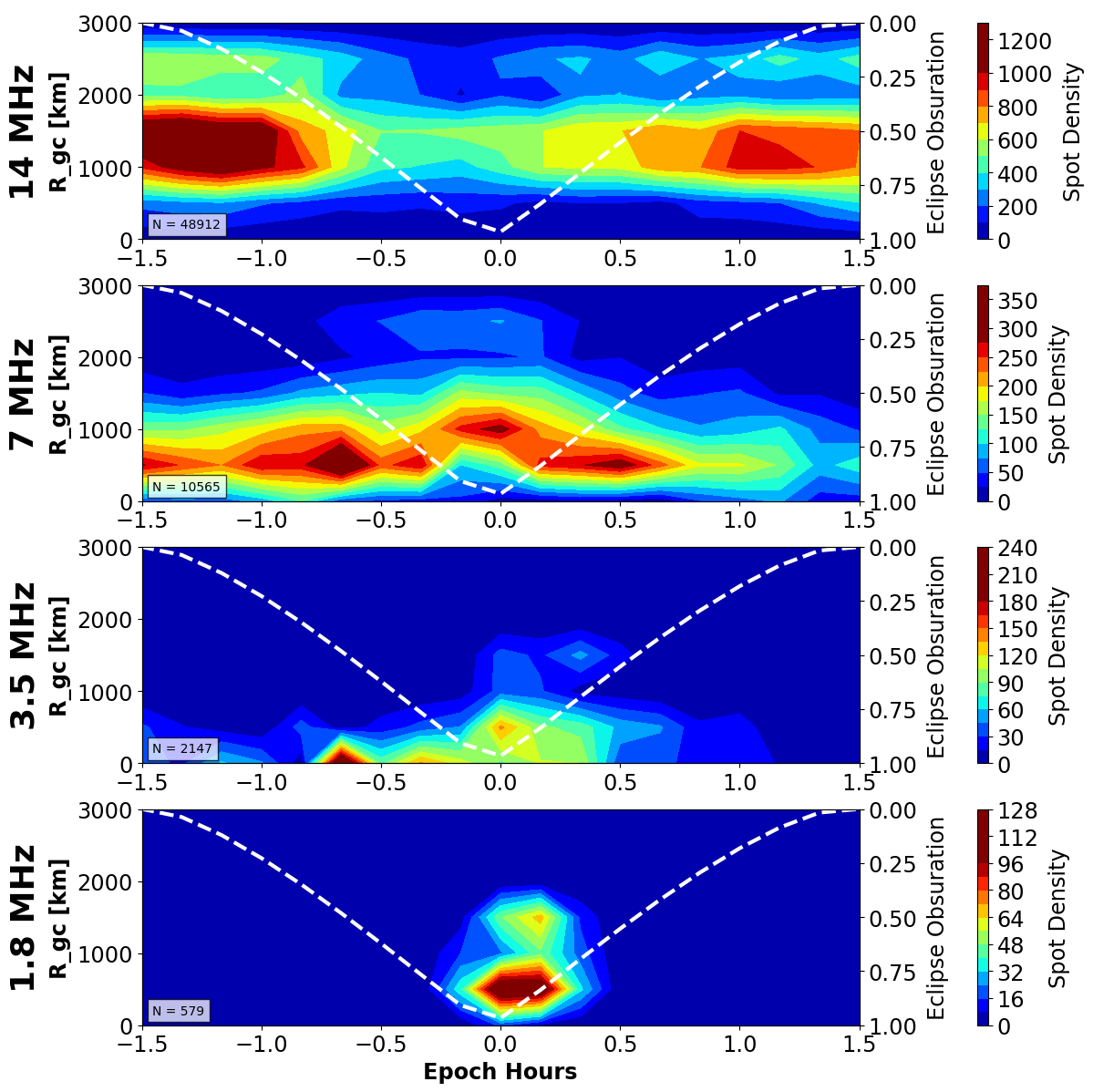Solar Eclipse QSO Party 2017

On August 21, 2017, a total solar eclipse caused the shadow of the moon to traverse the U.S. from Oregon to South Carolina in just over 90 minutes, causing dramatic changes in both the ionosphere and HF propagation. The Solar Eclipse QSO Party (SEQP) was a HamSCI-ARRL sponsored operating event to generate data to study ionospheric changes during the eclipse. Not a ham radio operator yet? Learn more about it from the American Radio Relay League.
SEQP Rules
- Final SEQP rules for 2017 are available here.
Science Results
- Initial SEQP Science Results using RBN data have been published by Frissell et al. (2018) in Geophysical Research Letters. The figures below are excerpts from the paper, showing RBN spot coverage during the SEQP and propapagtion effects relative to maximum eclipse time on the 1.8, 3.5, 7, and 14 MHz bands.

- Additional eclipse ionospheric science presentations were given at the 2018 HamSCI Meeting at NJIT. PDFs of most presentations are available for download from the meeting agenda page.
- Steve Cerwin, WA5FRF, published his WWV and WWVB amplitude and frequency measurement observations of the eclipse in his September/October 2018 QEX article "Ionospheric Disturbances at Dawn, Dusk, and During the 2017 Eclipse." Reprinted with permission; September/October 2018 QEX, copyright ARRL.
- Nick Hall-Patch, VE7DXR, conducted a study of AM radio observations and effects during the eclipse: Solar Eclipse 2017 DX from Western America
SEQP Data and Software
- The high-time resolution geolocated RBN data with eclipse obscuration values used in the Frissell et al. (2018) GRL paper is available for download from the GRL page under "Supporting Information".
- SEQP submitted logs and data are available from the Zenodo archive at https://doi.org/10.5281/zenodo.2483021.
- Community-submitted eclipse observations are available from the HamSCI Zenodo Community Page.
- Python code to calculate eclipse obscuration values for arbitrary dates, times, locations, and altitudes is available from https://github.com/HamSCI/eclipse_calculator.
Contest Results
The results are in! Congratulations to the top single operators, multi-operators, and RBN recievers. The SEQP was scored by W2NAF and K2AEM, with final write-up by N0AX. Thank you to all who participated!
Full results PDF: Solar Eclipse QSO Party - Full Results - Version 1.1.pdf
| Single Op | Total Score | Multi-Op | Total Score | |
|---|---|---|---|---|
| 1 | AA3B Bud Trench Boyertown, PA |
403,975 | W0ECC Elayer Contest Club St. Charles, MO (N0AX, N5OT, & KD0YJN) |
191,625 |
| 2 | K4BAI John Laney, III Columbus, GA |
224,502 | W0D DeSoto, MO (WB0SND & WB0TUA) |
112,553 |
| 3 | W1SJ Mitchell Stern Essex Junction, VT |
180,882 | W5GAD Jefferson Amateur Radio Club Metairie, LA (N5LIT, KG5GJT, N5HZ, & NO5W) |
93,651 |
| RBN Call | # Spots | Operator | QTH |
|---|---|---|---|
| WE9V | 54,874 | Chad Kurszewski | Bristol, WI |
| AA4VV | 40,574 | Thomas Berry |
Lexington, NC |
| KU7T | 31,762 | Andreas Hofmann | North Bend, WA |
| N4ZR-3 | 28,692 | Pete Smith | Phoenix, MD |
| NC7J | 28,564 | Utah Contest Club | Layton, UT |
| W3OA | 28,057 | Dick Williams | Mooresville, NC |
| N2GZ | 18,623 | Greg Zenger | North Stonington, CT |
| N0TA | 14,751 | John Reilly | Louisville, CO |
2017 Hamvention SEQP Presentation
The SEQP was coordinated by Nathaniel Frissell, W2NAF, at the New Jersey Institute for Technology Center for Solar Terrestrial Research (NJIT-CSTR) with support from the National Science Foundation grant AGS-1552188/479505-19C75 and the NJIT-CSTR. Thanks to the many collaborators, including those at Virginia Tech, Montclair State University, the MIT Haystack Observatory, the Johns Hopkins University Applied Physics Laboratory. Special thanks to the American Radio Relay League for publicizing the SEQP and the Reverse Beacon Network and PSKReporter for extra support in data collection.



